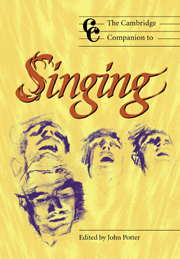Book contents
- Frontmatter
- 1 Introduction: singing at the turn of the century
- Part I Popular traditions
- Part II The voice in the theatre
- Part III Choral music and song
- 9 European art song
- 10 English cathedral choirs in the twentieth century
- 11 Sacred choral music in the United States: an overview
- Part IV Performance practices
- Notes
- Select bibliography
- Index
10 - English cathedral choirs in the twentieth century
from Part III - Choral music and song
Published online by Cambridge University Press: 28 September 2011
- Frontmatter
- 1 Introduction: singing at the turn of the century
- Part I Popular traditions
- Part II The voice in the theatre
- Part III Choral music and song
- 9 European art song
- 10 English cathedral choirs in the twentieth century
- 11 Sacred choral music in the United States: an overview
- Part IV Performance practices
- Notes
- Select bibliography
- Index
Summary
In the twentieth century the English cathedral and collegiate choir has consisted typically of about sixteen trebles – boys with unbroken voices, aged between about eight and thirteen (often with four additional ‘probationers’) – and at least six men taking the three lower parts. Numbers have varied from time to time in any particular choral foundation; in recent times York, Durham and Winchester Cathedral choirs have all used twelve men, as have Magdalen College, New College and Christ Church Cathedral in Oxford. King's College and St John's College in Cambridge have both used fourteen men's voices, each with six basses. St Paul's is the largest establishment of all, with thirty-eight boys and eighteen men.
Historians, journalists, critics and cathedral musicians themselves have been sure they can identify a style of singing peculiar to these choirs which they define by reference to purity of tone, accuracy in intonation, precision in ensemble, and an absence of rhetoric. The ‘essence’ of the cathedral choir said one authority is ‘the boy's voice’, and its men are ‘at their best when they blend with that clean white tone’. Again and again throughout the century the same epithets have been used to characterise the singing, ‘pure’, ‘otherworldly’, ‘ethereal’, ‘impersonal’; writers who do not admire the style refer to its ‘coldness’, its lack of ‘passion’ or ‘personality’, to the cultivation of beauty of sound at the expense of any real expressiveness, to ‘under-interpretation’, to rather barren meticulousness; a French critic writes about ‘performances that are millimetrées, as if they were mathematical exercises’.
- Type
- Chapter
- Information
- The Cambridge Companion to Singing , pp. 123 - 132Publisher: Cambridge University PressPrint publication year: 2000
- 4
- Cited by

